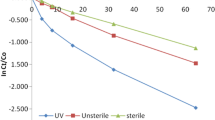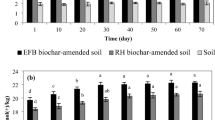Abstract
Purpose
The aim of the present work is to study the photodegradation of the pesticide carbaryl at the surface of soil and its fractions in order to have a better insight for the effect of the particle size and the organic matter content in its photochemical behavior. Moreover, the photoinductive properties of the soil and its fractions, in terms of reactive oxygen species formation, were also explored.
Materials and methods
A soil sample from Orange region (south of France) was fractionated to several fractions with different particle sizes. Some of these samples were characterized and treated to partially remove organic matter. The pesticide carbaryl was deposited at the surface, and the mixture was irradiated using a solar light simulator. The degradation of the pollutant was followed by HPLC analyses. Similar solid supports were studied for their photoinductive properties by using chemical probes for hydroxyl radical and singlet oxygen formation.
Results and discussion
The experimental results indicated that carbaryl degradation at the surface of soil and its fractions were efficient and appeared to follow pseudo first-order kinetics. The particle size was found to be an important parameter for the transformation efficiency, the large particles improved carbaryl degradation. Furthermore, natural organic matter showed a beneficial effect at low concentration (<2 % in weight) while inhibition effect was clearly present at higher concentrations.
Conclusions
The fractionation procedure and the organic matter removal allowed us to show that the major parameters that control the degradation efficiency are the particle size and organic matter concentration. Moreover, experiments with chemical probes proved the involvement of photoinduced processes implying not only singlet oxygen and hydroxyl radicals produced by the mineral and/or organic part of the soil but also the direct degradation of carbaryl.








Similar content being viewed by others
References
Bjerregaar R (1995) Placing of plant protection products on the market, Commission of the European Communities
Bradbury S (2008) Amended reregistration eligibility decision for carbaryl. In: Office of Prevention, Pesticides and Toxic Substances. US Environmental Protection Agency, Washington, DC, EPA. Available via DIALOG.http://www.epa.gov/oppsrrd1/REDs/carbaryl-red-amended.pdf. Accessed 09 Sept 2012
Carlson RW, Bradbury SP, Drummond R, Hammermeister DE (1998) Neurological effects on startle response and escape from predation by medaka exposed to organic chemicals. Aquat Toxicol 43:51–68
Chapalamadugu S, Chaudhry GR (1991) Hydrolysis of carbaryl by a Pseudomonas sp. and construction of a microbial consortium that completely metabolizes carbaryl. Appl Environ Microbiol 57:744–775
Choudhury PP, Dureja P (1997) Studies on photodegradation of chlorimuron-ethyl in soil. Pest Sci 51:201–205
Das YT (1990) Photodegradation of [1-naphthyl-14C]carbaryl on soil under artificial sunlight, vol 169–208 #87095. Department of Pesticide Regulation, Sacramento
de Bertrand N, Barceló D (1991) Photodegradation of the carbamate pesticides aldicarb, carbaryl and carbofuran in water. Anal Chim Acta 254:235–244
Delescluse C, Ledirac N, Li RY, Piechocki MP, Hines RN, Gidrol X, Rahmani R (2001) Induction of cytochrome P450 1A1 gene expression, oxidative stress, and genotoxicity by carbaryl acid thiabendazole in transfected human HepG2 and lymphoblastoid cells. Biochem Pharmacol 61:399–407
Demirbas A (1998) Spectrophotometric determination of carbaryl pesticide and its hydrolysis product in soil and strawberry samples. Sci Total Environ 220:235–241
Deuel LE, Brown KW, Price J, Turner FT (1985) Dissipation of carbaryl and the 1-naphthol metabolite in flooded rice fields. J Environ Qual 14:349–354
Foley S, Rotureau P, Pin S, Baldacchino G, Renault JP, Mialocq JC (2005) Radiolysis of confined water: production and reactivity of hydroxyl radicals. Angew Chem Int Ed 44:110–112
Haag WR, Hoigne J, Gassman E, Braun AM (1984) Singlet oxygen in surface waters—Part I: furfuryl alcohol as trapping agent. Chemosphere 13:631–640
Halladja S, Ter Halle A, Aguer JP, Boulkamh A, Richard C (2007) Inhibition of humic substances mediated photooxygenation of furfuryl alcohol by 2,4,6-trimethylphenol. Evidence for reactivity of the phenol with humic triplet excited states. Environ Sci Technol 41:6066–6073
Hapeman CJ, Bilboulian S, Anderson BG, Torrents A (1998) Structural influences of low-molecular-weight dissolved organic carbon mimics on the photolytic fate of atrazine. Environ Toxicol Chem 17:975–981
Juhler RK, Larsen S, Meyer O, Jensen ND, Spano M, Giwercman A, Bonde JP (1999) Human semen quality in relation to dietary pesticide exposure and organic diet. Arch Environ Contam Toxicol 37:415–423
Khalaf KD, Morales-Rubio A, de la Guardia M (1993) Simple and rapid flow injection spectrophotometric determination of carbaryl after liquid-liquid extraction. Anal Chim Acta 280:231–238
Louit G, Foley S, Cabillic J, Coffigny H, Taran F, Valleix A, Renault JP, Pin S (2005) The reaction of coumarin with the OH radical revisited: hydroxylation product analysis determined by fluorescence and chromatography. Radiat Phys Chem 72:119–124
Mathew L, Reddy MLP, Rao TP, Iyer CSP, Damodaran AD (1995) Simple spectrophotometric method for the determination of carbaryl in soil and insecticide formulations. Analyst 120:1799–1801
Mauriz E, Calle A, Abadb A, Montoya A, Hildebrandt A, Barcel D, Lechuga LM (2006) Determination of carbaryl in natural water samples by a surface plasmon resonance flow-through immunosensor. Biosens Bioelectron 21:2129–2136
Miller NE (1993) Metabolism of 14C-carbaryl under anaerobic aquatic soil conditions, vol 169–268 # 123598. Department of Pesticide Regulation, Sacramento
Newton GL, Milligan JR (2006) Fluorescence detection of hydroxyl radicals. Radiat Phys Chem 75:473–478
Nia Y, Xiao W, Kokot S (2009) Application of chemometrics methods for the simultaneous kinetic spectrophotometric determination of aminocarb and carbaryl in vegetable and water samples. J Hazard Mater 168:1239–1245
Nkedi-Kizza P, Brown KD (1998) Sorption, degradation, and mineralization of carbaryl in soils, for single pesticide and multiple pesticide systems. J Environ Qual 27:1318–1324
Romero E, Dios G, Mingorance MD, Matallo M, Peña A, Sanchez-Rasero F (1998) Photodegradation of mecoprop and dichlorprop on dry, moist and amended soil surfaces exposed to sunlight. Chemosphere 37:577–589
Samanidou V, Fytianos K, Pfister G, Bahadir M (1988) Photochemical decomposition of carbamate pesticides in natural-waters of northern Greece. Sci Total Environ 76:85–92
Si YB, Zhou J, Chen HM, Zhou DM, Yue YD (2004) Effect of humic substances on photodegradation of bensulfuron-methyl on dry soil surfaces. Chemosphere 56:967–972
Wauchope RD, Haque R (1973) Effects of pH, light and temperature on carbaryl in aqueous media. Bull Environ Contam Toxicol 9:257–260
Wolfe NL, Zepp RG, Baughman GL, Fincher RC, Gordon JA (1976) Chemical and photochemical transformation of selected pesticides in aquatic systems, USEPA, Athens, GA.123, EPA 600/3-76-067
Wolfe NL, Zepp RG, Paris DF (1978) Carbaryl, propham and chlorpropham: a comparison of the rates of hydrolysis and photolysis with the rate of biolysis. Water Res 12:565–571
Yue YD, Hua RM, Tang F, Chen XY (1993) Effect of soil particle size on distribution and photodegradation of selected pesticides in soil. J Anhui Agric Univ 20:309–314
Zepp RG, Wolfe N, Gordon L, Fincher RC (1976) Light-induced transformations of methoxychlor in aquatic systems. J Agric Food Chem 24:727–733
Zhang L, Li P, Gong Z, Oni Adeola A (2006) Photochemical behavior of benzo[a]pyrene on soil surfaces under UV light irradiation. J Environ Sci 18:1226–1232
Author information
Authors and Affiliations
Corresponding author
Additional information
Responsible editor: Dong-Mei Zhou
Rights and permissions
About this article
Cite this article
Siampiringue, M., Wong-Wah-Chung, P. & Sarakha, M. Impact of the soil structure and organic matter contents on the photodegradation of the insecticide carbaryl. J Soils Sediments 15, 401–409 (2015). https://doi.org/10.1007/s11368-014-0986-1
Received:
Accepted:
Published:
Issue Date:
DOI: https://doi.org/10.1007/s11368-014-0986-1




